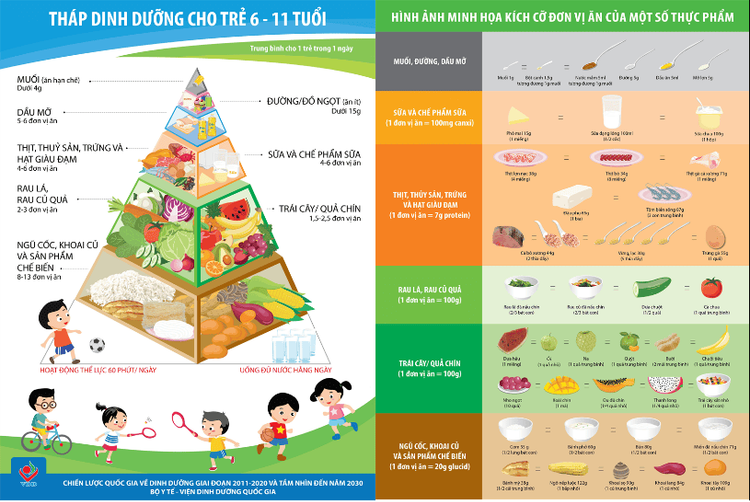This is an automatically translated article.
The article was professionally consulted by Doctor, Professor, Dr. Pham Nhat An - Director of Pediatrics Center cum Head of Pediatric Inpatient Department, Vinmec Times City International Hospital.Between the ages of 6 and 11 years old, children are attending primary school and starting to enter the pre-puberty stage, even some children have started puberty. Children need about 1,350 - 2,200 kcal / day, often need to eat more foods than before. Babies usually eat 4-5 times a day, including snacks. For a balanced diet for children this age, follow the nutrition pyramid below.
first . Nutrition pyramid for children from 6 to 11 years old
With 6 levels of the pyramid from the top down (from the top of the tower to the bottom of the tower), food groups are recommended for children to eat in different amounts, from less to more. The top floor is the top of the pyramid: The food group should be limited to children. In order for children to get all the necessary nutrients with a balanced ratio suitable to the recommended nutritional needs, it is necessary to feed them with the correct amount of food units corresponding to each food group shown on the pyramid. .Example: It's also important for children to eat snacks between meals, as these snacks can contribute up to a third of their calorie intake for the day. However, you should remind children instead of choosing to eat snacks, cakes, carbonated drinks, ... choose to eat healthy foods such as fruits, milk, sandwiches, cheese, cookies, etc. ...

Trắc nghiệm: Nhận biết sớm dấu hiệu chậm phát triển thể chất và trí tuệ ở trẻ
Nếu 6 tuổi không biết đếm số, 7 tuổi vẫn chưa phân biệt được giữa thực tế và tưởng tượng thì có thể bé chậm phát triển thể chất và trí tuệ hơn so với bạn bè cùng lứa. Bạn đã nhận biết được các dấu hiệu bất thường sớm này chưa? Cùng làm nhanh bài trắc nghiệm sau để trang bị thêm kiến thức cho mình nhé!
The following content is prepared under supervision of Thạc sĩ, Bác sĩ y khoa, Ma Văn Thấm , Nhi , Phòng khám Đa khoa Quốc tế Vinmec Dương Đông(Phú Quốc)
2. Through the nutrition pyramid and the size of the eating unit, what should a balanced diet for children 6-11 years old follow?
2.1. Salt and sugar Children need to limit their consumption of sugar and salt. Children 6-11 years old should only consume no more than 15g of sugar and no more than 4g of salt a day.2.2. Fat Fat is not a food group but contains essential nutrients, especially fat pressed from nuts such as peanuts, soybeans, sunflower,...
Note: Amount of fat in the daily diet of children 6 - 11 years old are classified by age groups as follows:
6 - 7 years old: 5 servings. 8 - 9 years old: 5.5 servings. 10-11 years old: 6 parts. One part fat is equivalent to 5g fat (about 1 teaspoon), one part oil is equivalent to 5ml cooking oil (about 2 teaspoons).
2.3. Protein Protein helps to form tissues. Pork, poultry, fish, shrimp, eggs are the most common foods that provide protein for the body. If you want your child to have a low-fat diet, give him mackerel, salmon, and herring. Limit your child's intake of fried meats that are high in saturated fat to avoid uncontrolled weight gain and increase the risk of heart disease.
Legumes such as green beans, black beans, peas along with soy products (such as tofu, soy milk, tofu) are also rich sources of plant-based protein.
The amount of meat, seafood, eggs and protein-rich grains in the daily diet of 6-11-year-old children is classified by age groups as follows:
6-7 years old: 4 servings. 8 - 9 years old: 5 parts. 10-11 years old: 6 parts. Note: In your baby's daily diet, a portion of meat, seafood, eggs, ... and protein-rich seeds provide 7g of protein equivalent:
Lean pork: 38g. Beef: 34g. Chicken with bones: 71g. Tofu: 71g (about 1 piece). Sea shrimp: 87g. Fish fillet: 44g. Chicken or duck eggs: 1 egg. Meat, fish, shrimp, eggs are foods that provide protein for the body, but it is necessary to limit children's intake of oily fried meats that increase the risk of heart disease.
2.4. Milk and dairy products Choose to buy milk and dairy products according to the criteria of fat-free or low-fat, with high calcium content because at this age the baby's skeletal system is developing.
The amount of milk and milk products of children 6-11 years old according to their daily servings is divided by age groups as follows:
6-7 years old: 4-5 servings. 8 - 9 years old: 5 parts. 10-11 years old: 6 parts. A serving of milk and dairy products provides 100mg of calcium equivalent: 1 piece of cheese weighs 15g or 1 cup of milk 100ml or 1 box of yogurt 100g.
2.5. Starch Babies should eat whole grains to ensure they receive the highest source of nutrients.
Amount of cereals and cereal products in the diet of 6–11 year olds:
6–7 years old: 8 – 9 servings. 8-9 years old: 10-11 parts. 10-11 years old: 12-13 parts. A serving of cereals and cereal products provides 20g of glucide equivalent to:
Rice: 1/2 bowl of rice about 55g. Pho: 1/2 small bowl about 60g. Vermicelli: 1/2 small bowl, about 80g. Bread: 1/2 loaf about 38g. Corn: 1 boiled corn about 122g. 2.6. Vegetables, fruits Vegetables are rich in vitamins and fiber to help purify the body. Your child's daily meal should have at least two or three different types of vegetables. Choose colorful vegetables to stimulate your baby's vision, helping them eat more deliciously.
One portion of vegetables equals 100g. The number of vegetables for children 6 - 11 years old is divided by age groups as follows:
6 - 7 years old: 2 servings. 8 - 9 years old: 2 - 2.5 servings. 10-11 years old: 3 parts. Fruits are a great source of vitamin C and many other vitamins and minerals and much-needed nutrients. You should give your baby seasonal fruit to ensure that the fruit is always fresh and to limit the residue of pesticides.
If your baby doesn't like fruit, give him juice instead. Avoid adding sugar, cream, ... because they may not be good for your baby's health.
The amount of fruit/ripe fruit in the diet of 6 - 11 year olds is divided by age groups as follows:
6 - 7 years old: 1.5 - 2 servings. 8 - 9 years old: 2 servings. 10 - 11 years old: 2 - 2.5 servings. 2.7. Water and liquid drinks Every day, children 6-11 years old need to drink an average of 1,300-1,500ml including water, milk and juice, equivalent to 6-8 glasses of water per day for a healthy body and good metabolism.
Limiting children to drink carbonated drinks, soft drinks, and soft drinks with a lot of sugar because they are rich in energy but have very low nutritional content, increasing the risk of obesity in children.
In addition to a balanced, scientific diet, your baby needs at least 1 hour of physical activity a day to have a healthy lifestyle. Training time can be divided into several times a day. You should encourage your child to run and jump, kick a ball, play catch, jump rope, kick shuttlecock, etc. to increase flexibility, speed, flexible reaction and coordination ability.
The nutrition pyramid for babies will be both a standard and a tool, helping parents to choose healthy foods for their children. However, if your child has any health or nutrition-related problems, consult a nutritionist and doctor for the best advice.

Please dial HOTLINE for more information or register for an appointment HERE. Download MyVinmec app to make appointments faster and to manage your bookings easily.
Source: National Institute of Nutrition














